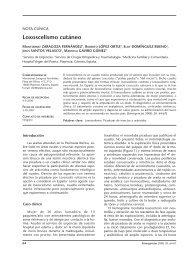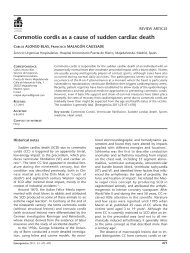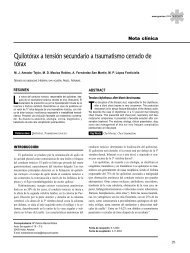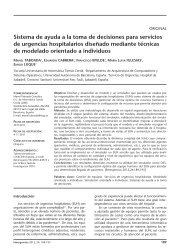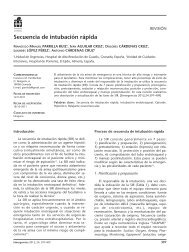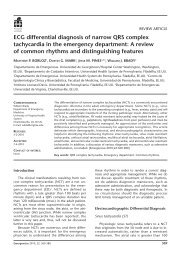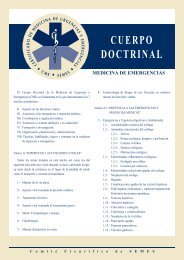Traumatic Intercostal Pulmonary Hernia - Semes
Traumatic Intercostal Pulmonary Hernia - Semes
Traumatic Intercostal Pulmonary Hernia - Semes
Create successful ePaper yourself
Turn your PDF publications into a flip-book with our unique Google optimized e-Paper software.
LETTERS TO THE EDITOR<br />
bed, with air and multiple images suggestive of calcium<br />
stones. We performed puncture and aspiration of the<br />
lesion which drew out purulent fluid, so a percutaneous<br />
drain was placed. The final diagnosis was cholecystitis<br />
complicated by a subphrenic abscess.<br />
For the diagnosis of subphrenic abscess it is<br />
especially important to correlate information obtained<br />
from medical history, examination, laboratory<br />
data and the findings of imaging tests. One<br />
needs to bear in mind that the existence of septic<br />
intra-abdominal or pelvic inflammatory processes,<br />
hollow visceral perforations, abdominal<br />
trauma - primarily of the hypochondria - or abdominal<br />
surgery may favour the development of<br />
this picture. Thus subphrenic abscess should be<br />
suspected in any patient with a history such as<br />
that here described and the signs and symptoms<br />
of sepsis; physical examination shows limited respiratory<br />
movements, pain on compression of the<br />
base of the chest, upper quadrant percussion<br />
pain or elevation of the hemidiaphragm on the<br />
affected side. Treatment is aimed at controlling<br />
sepsis with antibiotics and abscess drainage either<br />
percutaneously under ultrasound or CT control,<br />
or surgery.<br />
References<br />
1 Gervais DA, Ho CH, O’Neill MJ, Arellano RS, Hahn PF, Mueller PR.<br />
Recurrent abdominal and pelvic abscesses: incidence, results of repeated<br />
percutaneous drainage, and underlying causes in 956 drainages.<br />
Am J Roentgenol. 2004;182:463-6.<br />
2 Cinat ME, Wilson SE, Din AM. Determinants for successful percutaneous<br />
image-guided drainage of intra-abdominal abscess. Arch Surg.<br />
2002;137:845-9.<br />
Chiladiti sign<br />
Estela FERNÁNDEZ CUADRIELLO,<br />
Ángela MEILÁN MARTÍNEZ,<br />
Bonel ARGÜELLES GARCÍA,<br />
Susana Ana ÁLVAREZ GONZÁLEZ<br />
Servicio de Urgencias. Hospital Universitario<br />
Arnau de Vilanova. Lleida, Spain.<br />
Sir,<br />
Chilaiditi sign is a rare radiological finding that<br />
may be confused with images leading to misdiagnosis<br />
of chest and abdominal trauma.<br />
A 45 year-old man with unremarkable medical<br />
history was admitted to our centre after a motorcycle<br />
accident in which he crashed into a wall. Initial<br />
examination showed: Glasgow Coma Scale score of<br />
15, blood pressure 140/80 mmHg, heart rate 93<br />
bpm, respiratory rate 30 rpm, arterial SaO 2 96% and<br />
FiO 2 0.5. He presented chest pain, left dorsal erosion<br />
and hypophonesis, subcutaneous emphysema, good<br />
mechanical ventilation without cervical tracheal deviation<br />
or jugular engorgement, correct cardiac auscultation<br />
and pulses, abdomen soft and depressible,<br />
without pain or peritonitis, and stable pelvis, no evidence<br />
of spinal injury, with multiple contusion and<br />
erosion of the limbs. Plain chest X-ray showed a<br />
small pneumothorax and left pleural effusion, fractured<br />
left ribs 3, 4, 5, 6, 7, and an image of air between<br />
the liver and the diaphragm on the right (Figure<br />
1) obtained with computed tomography (CT) scan<br />
which was diagnosed as Chilaiditi sign. Follow up CT<br />
studies showed left lung contusion and a space-occupying<br />
hepatic lesion, compatible with hemangioma.<br />
After chest drainage, epidural analgesia and ventilatory<br />
physiotherapy, he regained physiological<br />
respiration.<br />
Chilaiditi sign is found in 0.28% of standing<br />
chest X-rays 1 , predominantly in men over 65<br />
years of age 2 . First described in 1910 by the radiologist<br />
Demetrius Chilaiditi Demetrius, it is a<br />
positional anomaly of the colon, and rarely the<br />
small intestine, characterized by the interposition<br />
of a loop of the colon between the right<br />
hemidiaphragm and the liver 3 , rarely found on<br />
the left side 4 . It is usually asymptomatic although<br />
some patients report abdominal discomfort,<br />
insidious constipation and nausea that<br />
are usually self-limiting, although the clinical relationship<br />
with the colon interposition is controversial<br />
3 . As predisposing factors, certain authors<br />
have cited liver atrophy, abnormal colon<br />
position and elongation, paralysis of the phrenic<br />
nerve, hypothyroidism, obesity and mental<br />
disorders 4 . The emergence of volvulus 5 is a rare<br />
complication. The absence of abdominal<br />
symptoms, or free intra-abdominal fluid/gas on<br />
Eco FAST and CT scan in the ED in our case, ruled<br />
out pneumoperitoneum. Despite the scarce<br />
clinical symptoms associated with traumatic<br />
diaphragmatic hernia6 and the limited diagnostic<br />
capacity of X-ray and CT scan for this condition<br />
7 , radiological study and the mechanism of<br />
impact with high left chest injuries, less frequent<br />
on the right (5 - 20% of traumatic<br />
diaphragmatic rupture (0.8 to 3.6%) 8 , right<br />
traumatic diaphragmatic rupture with herniation<br />
of bowel contents was considered unlikely.<br />
Other lesions such as subphrenic abscess or<br />
hydatid cyst 9 were ruled out by the absence of<br />
findings in the laboratory tests and medical history.<br />
Some authors recommend supine chest x-<br />
ray for diagnosis 10 . The use of CT scan helps to<br />
confirm the diagnosis. Caution should be taken<br />
when performing invasive techniques in the<br />
Emergencias 2010; 22: 154-160 159



